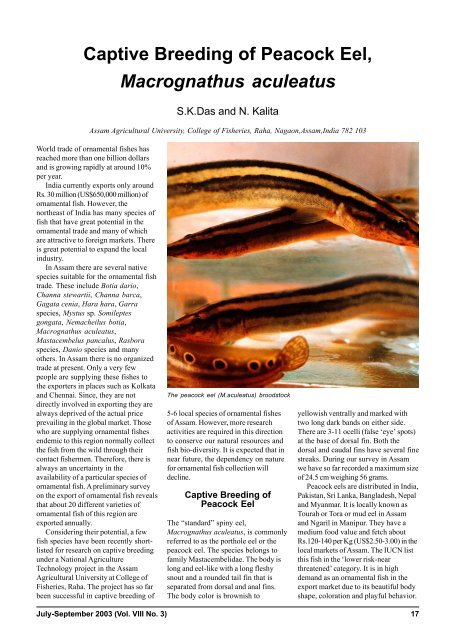Captive Breeding Of Peacock Eel, Macrognathus Aculeatus - Library
Captive Breeding Of Peacock Eel, Macrognathus Aculeatus - Library
Captive Breeding Of Peacock Eel, Macrognathus Aculeatus - Library
You also want an ePaper? Increase the reach of your titles
YUMPU automatically turns print PDFs into web optimized ePapers that Google loves.
<strong>Captive</strong> <strong>Breeding</strong> of <strong>Peacock</strong> <strong>Eel</strong>,<strong>Macrognathus</strong> aculeatusS.K.Das and N. KalitaAssam Agricultural University, College of Fisheries, Raha, Nagaon,Assam,India 782 103World trade of ornamental fishes hasreached more than one billion dollarsand is growing rapidly at around 10%per year.India currently exports only aroundRs. 30 million (US$650,000 million) ofornamental fish. However, thenortheast of India has many species offish that have great potential in theornamental trade and many of whichare attractive to foreign markets. Thereis great potential to expand the localindustry.In Assam there are several nativespecies suitable for the ornamental fishtrade. These include Botia dario,Channa stewartii, Channa barca,Gagata cenia, Hara hara, Garraspecies, Mystus sp. Somileptesgongata, Nemacheilus botia,<strong>Macrognathus</strong> aculeatus,Mastacembelus pancalus, Rasboraspecies, Danio species and manyothers. In Assam there is no organizedtrade at present. Only a very fewpeople are supplying these fishes tothe exporters in places such as Kolkataand Chennai. Since, they are notdirectly involved in exporting they arealways deprived of the actual priceprevailing in the global market. Thosewho are supplying ornamental fishesendemic to this region normally collectthe fish from the wild through theircontact fishermen. Therefore, there isalways an uncertainty in theavailability of a particular species ofornamental fish. A preliminary surveyon the export of ornamental fish revealsthat about 20 different varieties ofornamental fish of this region areexported annually.Considering their potential, a fewfish species have been recently shortlistedfor research on captive breedingunder a National AgricultureTechnology project in the AssamAgricultural University at College ofFisheries, Raha. The project has so farbeen successful in captive breeding ofThe peacock eel (M.aculeatus) broodstock5-6 local species of ornamental fishesof Assam. However, more researchactivities are required in this directionto conserve our natural resources andfish bio-diversity. It is expected that innear future, the dependency on naturefor ornamental fish collection willdecline.<strong>Captive</strong> <strong>Breeding</strong> of<strong>Peacock</strong> <strong>Eel</strong>The “standard” spiny eel,<strong>Macrognathus</strong> aculeatus, is commonlyreferred to as the porthole eel or thepeacock eel. The species belongs tofamily Mastacembelidae. The body islong and eel-like with a long fleshysnout and a rounded tail fin that isseparated from dorsal and anal fins.The body color is brownish toyellowish ventrally and marked withtwo long dark bands on either side.There are 3-11 ocelli (false ‘eye’ spots)at the base of dorsal fin. Both thedorsal and caudal fins have several finestreaks. During our survey in Assamwe have so far recorded a maximum sizeof 24.5 cm weighing 56 grams.<strong>Peacock</strong> eels are distributed in India,Pakistan, Sri Lanka, Bangladesh, Nepaland Myanmar. It is locally known asTourah or Tora or mud eel in Assamand Ngaril in Manipur. They have amedium food value and fetch aboutRs.120-140 per Kg (US$2.50-3.00) in thelocal markets of Assam. The IUCN listthis fish in the ‘lower risk-nearthreatened’ category. It is in highdemand as an ornamental fish in theexport market due to its beautiful bodyshape, coloration and playful behavior.July-September 2003 (Vol. VIII No. 3) 17
eneficial microbes. The presence ofa small quantity of pathogenicmicrobes in the water and animals isnormal and acceptable. If we try tototally eradicate pathogens we willdisrupt the micro ecological balance,which may induce loss ofphysiological balance of the stock,leading to proliferation of pathogensand disease.• Controlling farm volume andimplementing rotational farmingpractices with fallowing of cultureareas is a highly effective diseasecontrol measure. As the number offarms in an area grows more diseaseproblems are experienced. Limitingthe number and area of farms helpsto prevent major disease problemsand provides the best benefit andconsistent development offreshwater shrimp and crabaquaculture. Since some pathogensare specific to a particular host,allowing farming areas to restbetween crops can keep pathogennumbers down and maintain thesafety of products, quarantine riskand impact on the environment.• Implement health managementcentered on disease prevention andprotection of the environment, whilenot rejecting responsible drug usageas a useful tool. At present, “healthmanagement” is a resoundingslogan in aquaculture and key tosuccessful culture. Healthmanagement includes scientificbreeding, farming, water usage, andfeeding and drug usage.Appropriate drug usage requires thefollowing: A diagnosis must be madein order to select an appropriatedrug and treatment regime. Otherfactors contributing to the disease,such as environmental conditions ornutrition must be addressedsimultaneously. Drugs that arepotentially harmful to humans or theenvironment should not be used,withdrawal periods must be appliedto allow drug residues to beeliminated.• Effectively apply disease quarantineprocedures and monitor in order tobring large-scale epidemics undercontrol. Emphasis should be placedon investigating diseaseepidemiology including season, areaand condition in order to identifyimportant factors and times.Quarantine measures should beestablished and their effectivenessmonitored; and appropriateregulatory and institutional controlsimplemented.• Develop and make use of biologicalproducts and techniques. Biologicalproducts include vaccines andtoxoids, high-immune serum,interferon, antitoxins and othertreatment products. Recentdevelopments in these areas havegreat potential for aquaculture.The 3 weeks old young fry of M.aculeatus<strong>Captive</strong> breeding of M.aculeatusAbout the AuthorsContinued from page 18Dr S.K.Das is an Associate professorof Assam Agricultural University atCollege of Fisheries, Assam, India, e-mail: skdas01@yahoo.com. The secondauthor is a senior research fellowworking under the project.Set Size of Brood Fish Water Spawning Survival1. Male:17.5cm (15.4 g)19.2 (17.0g)29.5 0 CpH 7.912 %(at 30 days)Female:18.0cm (19.50g)20.30cm (21.20g)2. Male:18.5cm (16.6g)18.3cm (16.0g).Female:20.0cm (20.90g)19.10cm (19.50g)3. Male:17.3 cm (10.60g)16.50cm (8.0g)Female:18.50cm (13.5g).29 0 CpH: 8.228.3 0 CpH: 7.6Fertilization: 88%Hatching: 48%Incubation time:30-33 hrs.Fertilization: 92%Hatching: 35%Incubation time:36-38 hrs.Fertilization: 85%Hatching:60%Incubation time:40- 42 hrs.Fecundity and Gonado-somatic Index of <strong>Macrognathus</strong> aculeatusFish (g) Ovary (g) GSI ratio Sample (g) No.of eggs Eggs/g fish11.9 1.40 1:8.50 0.40 164 4816.6 1.80 1:9.20 0.20 75 4015.9 1.70 1:9.30 0.40 179 4735.0 3.30 1:10.60 0.40 320 7525.8 2.80 1:9.20 0.30 172 6221.0 2.20 1:9.36 0.34 182 54.409 %(at 30 days)14 %(at 30 days)July-September 2003 (Vol. VIII No. 3) 21

















